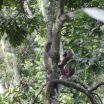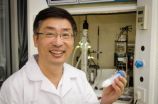(Press-News.org) An international team of scientists led by Dr Kate Sanders from the University of Adelaide, and including Dr Mike Lee from the South Australian Museum, has uncovered how some sea snakes have developed 'shrunken heads' – or smaller physical features than their related species.
Their research is published today in the journal Molecular Ecology (doi: 10.1111/mec.12291).
A large head – "all the better to eat you with" - would seem to be indispensable to sea snakes, which typically have to swallow large spiny fish. However, there are some circumstances where it wouldn't be very useful: sea snakes that feed by probing their front ends into narrow, sand eel burrows have evolved comically small heads.
The team has shown normal-shaped sea snakes can evolve such "shrunken heads" very rapidly. This process can rapidly lead to speciation (one species splitting into two). The small-headed populations are also much smaller in absolute size than their ancestors, and these shape and size differences mean they tend to avoid interbreeding with their large-headed ancestors.
Dr Lee says, "A team led by my colleague Dr Kate Sanders at the University of Adelaide has been investigating genetic differences across all sea snakes, and we noticed that the blue-banded sea snake (Hydrophis cyanocinctus) and the slender-necked sea snake (Hydrophis melanocephalus) were almost indistinguishable genetically, despite being drastically different in size and shape.
"The slender-necked sea snake is half the size, and has a much smaller head, than the blue-banded sea snake.
"This suggested they separated very recently from a common ancestral species and had rapidly evolved their different appearances. One way this could have happened is if the ancestral species was large-headed, and a population rapidly evolved small heads to probe eel burrows - and subsequently stopped interbreeding with the large-headed forms."
Dr Sanders says the research could have wider implications in other scientific studies: "our results highlight the viviparous sea snakes as a promising system for studies of speciation and adaptive radiation in marine environments."
### END
Scientists discover reasons behind snakes' 'shrinking heads'
2013-03-20
ELSE PRESS RELEASES FROM THIS DATE:
Hunting for meat impacts on rainforest
2013-03-20
Hunting for meat in the African rainforests has halved the number of primates. However, the hunting also has other negative consequences. The decline in the number of primates causes a reduction in the dispersal of seed by the primates, and this leads to a reduction in the numbers of important fruit trees and changes to the rainforest. This has been shown in new research from Lund University in Sweden.
The destruction of the world's rainforests is generally recognised as a major problem. However, it is not only felling and clear-cutting that change the rainforest. A research ...
NTU scientist develops a multi-purpose wonder material to tackle enviromental challenges
2013-03-20
A new wonder material that can generate hydrogen, produce clean water and even create energy.
Science fiction? Hardly, and there's more - It can also desalinate water, be used as flexible water filtration membranes, help recover energy from desalination waste brine, be made into flexible solar cells and can also double the lifespan of lithium ion batteries. With its superior bacteria-killing capabilities, it can also be used to develop a new type of antibacterial bandage.
Scientists at Nanyang Technological University (NTU) in Singapore, led by Associate Professor Darren ...
Thin films of nickel and iron oxides yield efficient solar water-splitting catalyst
2013-03-20
EUGENE, Ore. -- (March 20, 2013) -- University of Oregon chemists say that ultra-thin films of nickel and iron oxides made through a solution synthesis process are promising catalysts to combine with semiconductors to make devices that capture sunlight and convert water into hydrogen and oxygen gases.
Researchers in the Solar Materials and Electrochemistry Laboratory of Shannon Boettcher, professor of chemistry, studied the catalyst material and also developed a computer model for applying catalyst thin films in solar water-splitting devices as a tool to predict the effectiveness ...
New study highlights strong anti-cancer properties of soybeans
2013-03-20
Soybean meal is a bi-product following oil extraction from soybean seeds. It is rich in protein, which usually makes up around 40% of the nutritional components of the seeds and dependent on the line, and can also contain high oleic acid (a monounsaturated omega-9 fatty acid).
The study looked at the role soybeans could have in the prevention of cancer. Using a variety of soybean lines which were high in oleic acid and protein, the researchers looked to monitor bioactivity between the peptides derived from the meals of soybean and various types of human cancer cells. ...
Research show little support for controls on overseas fertility treatment
2013-03-20
PROBLEMS in accessing donor sperm and eggs at home appear to be behind a reported increase in the number of UK citizens who seek fertility treatment abroad, despite the fact that this is widely seen as risky. Now, a team of academic experts, including a University of Huddersfield professor, have investigated the phenomenon and analysed the attitudes of health professionals.
The researchers found little support for legal controls on cross-border fertility treatment, but UK-based clinicians stressed the importance of checking out overseas fertility clinics in order to ...
Low-income parents say child care subsidies help them keep jobs
2013-03-20
COLUMBUS, Ohio -- Low-income parents who receive federal child care subsidies are more satisfied with their child care than those who don't receive such help, according to a recent study.
A survey of parents in Missouri found that nearly nine in 10 subsidy recipients reported the funds were a tremendous boost to their family's ability to work and make a living.
In addition, those who received subsidies were less likely to have problems with work flexibility, indicating that they had an easier time balancing work and family.
The results show the importance of child ...
Measuring mercury: Common test may overestimate exposure from dental amalgam fillings
2013-03-20
ANN ARBOR—A common test used to determine mercury exposure from dental amalgam fillings may significantly overestimate the amount of the toxic metal released from fillings, according to University of Michigan researchers.
Scientists agree that dental amalgam fillings slowly release mercury vapor into the mouth. But both the amount of mercury released and the question of whether this exposure presents a significant health risk remain controversial.
Public health studies often make the assumption that mercury in urine (which is composed mostly of inorganic mercury) can ...
Peru surprises with 2 new amazing species of woodlizards
2013-03-20
Two new woodlizard species have been uncovered from poorly explored areas of the Peruvian jungles. The males have beautiful body colouration with a distinctive green pattern before a dark brown and black background. It is assumed that the two species share the same territory, with only a slight difference in altitude ranges, which makes their biological divergence intriguing from an evolutionary point of view. The study was published in the open access journal Zookeys.
Being traditionally regarded as a group with a low species diversity, recent fieldwork on Enyalioides ...
America's lower-wage workforce: Employer and worker perspectives
2013-03-20
Chicago, March 20, 2013—The Associated Press-NORC Center for Public Affairs Research announces the publication and availability of a major two-part study designed to better understand how lower-wage workers and those who employ them view such jobs and the opportunities for advancing the careers of lower wage workers. Funding for the surveys was provided to the AP-NORC Center by the Joyce Foundation, the Hitachi Foundation, and NORC at the University of Chicago.
"During the Great Recession that began in 2008, about one-half of the U.S. jobs lost were middle-class ...
'Toxicity map' of brain may help protect cognition for cancer patients
2013-03-20
WINSTON-SALEM, N.C. – March 20, 2013 – New research from Wake Forest Baptist Medical Center is giving radiation oncologists who treat brain tumors a better understanding of how to preserve the brain's functions while still killing cancer.
Ann M. Peiffer, Ph.D., assistant professor of radiation oncology at Wake Forest Baptist, and colleagues looked at how radiation treatment to different brain areas impacts function to help protect cognition for patients during and after radiation therapy and beyond.
Radiation treatment of organs with cancer is designed to give enough ...



